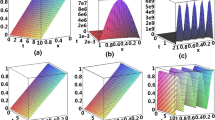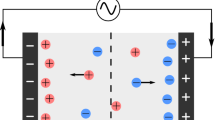Abstract
A theory is presented for appearance of periodic band patterns of ion concentration and electric potential associated with electric current surrounding a unicellular or multicellular system of a cylindrical shape. A flux continuity at the membrane (or the surface) is reduced to a nonlinear equation expressing passive and active fluxes across the membrane and intracellular diffusion flux. It is shown that, when an external parameter is varied from the sub-critical region, i.e. the homogeneous flux state, a symmetry breaking along a longitudinal axis usually appears prior to the one along a circumferential direction. The spectrum analysis shows that the correlation length is longer in the longitudinal direction. Growth of the band pattern from a patch-shaped pattern is demonstrated by the use of numerical calculations of proton concentration on the two-dimensional space of cylindrical surface. An experimental example of formative process of H+ banding is given for the internodal cell ofChara. It is shown that small patches on the surface decline or are sometimes gathered to the band surrounding the circle. The resulting pattern is suggested as a kind of dissipative structure appearing far from equilibrium.
Similar content being viewed by others
Literature
Avnir, D. and M. Kagan. 1984. “Spatial Structures Generated by Chemical Reactions at Interfaces.”Nature,307, 717–720.
Bisson, M. A. and N. A. Walker. 1980. “TheChara Plasmalemma at High pH. Electrical Measurements Show Rapid Specific Passive Uniport of H+ or OH−.”J. Membrane Biol.,56, 1–7.
Boels, H. D. and U.-P. Hansen. 1982. “Light and Electrical Current Stimulate the Same Feedback System inNitella.”Plant Cell Physiol.,23, 343–346.
Chilcott, T. C., H. G. L. Coster, K. Ogata and J. R. Smith. 1983. “Spatial Variation of the Electrical Potential ofChara australis—II. Membrane Capacitance and Conductance as a Function of Frequency.”Aust. J. Plant. Physiol.,10, 353–362.
Dorn, A. and M. H. Weisenseel. 1984. “Growth and the Current Pattern around Internodal Cells ofNitella flexilis L.”J. exp. Bot. 35, 373–383.
Erneux, T., J. Hiernaux and G. Nicolis. 1978. “Turing's Theory in Morphogenesis.”Bull. math. Biol. 40, 771–789.
Ferrier, J. M. 1980. “Extracellular Ion Transport.”J. theor. Biol. 85, 739–743.
Gransdorff, P. and I. Prigogine. 1971.Thermodynamic Theory of Structure, Stability and Fluctuations. London: Wiley-Interscience.
Haken, H. 1978.Synergetics—An Introduction. Berlin: Springer-Verlag.
Hansen, U.-P. 1978. “Do Light-induced Changes in the Membrane Potential ofNitella Reflect the Feedback Regulation of a Cytoplasmic Parameter?”J. Membrane Biol. 41, 197–224.
— 1985. “Messung und Interpretation der Kinetik der Lichtwirkung auf den Elektrophoretischen Transport über die Plasmamembran der AlgeNitella.”Ber. Deutsch. Bot. Ges. 92, 105–118.
Harold, F. M. 1982. “Pumps and Currents: A Biological Perspective.” InCurrent Topics in Membranes and Transport. Vol.16, C. L. Slayman (Ed.), pp. 486–516. New York: Academic Press.
Hayashi, K., T. Fujiyoshi, K. Toko and K. Yamafuji. 1987. “Periodic Pattern of Electric Potential inChara Internodal Cell.”J. Phys. Soc. Jpn. 56, 810–820.
Herschkowitz-Kaufman, M. 1975. “Bifurcation Analysis of Nonlinear Reaction-diffusion Equation—II. Steady State Solutions and Comparison with Numerical Simulations.”Bull. math. Biol. 37, 589–636.
Iiyama, S., K. Toko and K. Yamafuji. 1985. “Band Structure of Surface Electric Potential in Growing Roots.”Biophys. Chem. 21, 285–293.
Jaffe, L. F. 1979. “Control of Development by Ionic Currents.” InMembrane Transduction Mechanisms, R. A. Cone and J. E. Dowling (Eds), pp. 199–231. New York: Raven Press.
Kawamura, G., T. Shimmen and M. Tazawa. 1980. “Dependence of the Membrane Potential ofChara Cells on External pH in the Presence or Absence of Internal Adenosinetriphosphate.”Planta 149, 213–218.
Lax, M. 1960. “Fluctuation from the Nonequilibrium Steady State.”Rev. mod. Phys. 32, 25–64.
Lucas, W. J. and J. Dainty. 1977. “Spatial Distribution of Functional OH− Carriers along a Characean Internodal Cell: Determined by the Effect of Cytochalasin B on H14CO3 − Assimilation.”J. Membrane Biol. 32, 75–92.
Maginu, K. 1975. “Reaction-diffusion Equation Describing Morphogenesis—I. Waveform Stability of Stationary Wave Solutions in a One-dimensional Model.”Math. Biosci. 27, 17–98.
Metraux, J.-P., P. A. Richmond and L. Taiz. 1980. “Control of Cell Elongation inNitella by Endogeneous Cell Wall pH Gradients.”Plant Physiol. 65, 204–210.
Nicolis, G. and I. Prigogine. 1977.Self-organization in Nonequilibrium Systems. New York: Wiley-Interscience.
Nuccitelli, R. and L. F. Jaffe. 1975. “The Pulse Current Pattern Generated by Developing Fucoid Eggs.”J. Cell Biol. 64, 636–643.
Ogata, K. 1983. “The Water-film Electrode, a New Device for Measuring the Characean Electro-potential and-cunductance Distributions along the Length of the Internode.”Plant Cell Physiol. 24, 695–703.
—, T. C. Chilcott and H. G. L. Coster. 1983. “Spatial Variation of the Electrical Properties ofChara australis—I. Electrical Potential and Membrane Conductance.”Aust. J. Plant Physiol. 10, 339–351.
— and U. Kishimoto. 1976. “Rythmic Change of Membrane Potential and Cyclosis ofNitella Internode.”Plant Cell Physiol. 17, 201–207.
—, K. Toko, T. Fujiyoshi and K. Yamafuji. 1987. “Electric Inhomogeneity in Membrane of Characean Internode Influenced by Light/dark Transition, O2, N2, CO2-free Air and Extracellular pH.”Biophys. Chem.,26, 71–81.
Oosawa, F. 1975. “The Effect of Field Fluctuation on a Macromolecular System.”J. theor. Biol. 52, 175–186.
— and Y. Nakaoka. 1977. “Behavior of Micro-organisms as Particles with Internal State Variables.”J. theor. Biol. 66, 747–761.
Palaniandavar, N., F. D. Gnanam and P. Ramadamy. 1984. “Diffusion Controlled Asutocatalytic Growth of Recent Periodic Precipitation of Cadmium Sulphide in Iyophillic Colloid.”J. chem. Phys. 80, 3446–3450.
Paeceman, D. W. and H. H. Rachford. 1955. “The Numerical Solution of Parabolic and Elliptic Differential Equations.”J. Soc. indust. appl. Math. 3, 28–41.
Smith, P. T. and N. A. Walker. 1981. “Studies on the Perfused Plasmalemma ofChara corallina—1. Current-voltage Curves: ATP and Potassium Dependence.”J. Membrane Biol. 60, 223–236.
Spear, D. G., J. K. Barr and C. E. Barr. 1969. “Localization of Hydrogen Ion and Chloride Ion Fluxes inNitella.”J. gen. Physiol. 54, 397–417.
Stanley, H. E. 1971.Introduction to Phase Transitions and Critical Phenomena. Oxford: Clarendon Press.
Takeshige, K., T. Shimmen and M. Tazawa. 1986. “Quantitative Analysis of ATP-dependent H+ Efflux and Pump Current Driven by an Electrogenic Pump inNitellopsis obtusa.”Plant Cell Physiol. 27, 337–348.
Toko, K., H. Chosa and K. Yamafuji. 1985. “Dissipative Structure in theCharaceae, Spatial Pattern of Proton Flux as a Dissipative Structure in Characean Cells.”J. theor. Biol. 114, 127–175.
—, T. Fujiyoshi, K. Ogata, H. Chosa and K. Yamafuji. 1987a. “Theory of Electric Dissipative Structure in Characean Internode.”Biophys. Chem.,27, 149–172.
—, K. Hayashi and K. Yamafuji. 1986. “Spatio-temporal Organization of Electricity in Biological Growth.”Trans. IECE Jap. E69, 485–487.
Toko, K., K. Hayashi, T. Yoshida, T. Fujiyoshi and K. Yamafuji. 1988. “Oscillations of Electric Spatial Pattern Emerging from the Homogeneous State in Characean Cells.”Eur. Biophys. J. 16 (in press).
—, S. Iiyama, C. Tanaka, K. Yayashi, K. Yamafuji and K. Yamafuji. 1987b. “Relation of Growth Process to Spatial Patterns of Electric Potential and Enzyme Activity in Bean Roots.”Biophys. Chem. 27, 39–58.
—— and K. Yamafuji. 1984. “Band-type Dissipative Structure in Ion Transport Systems with Cylindrical Shape.”J. phys. Soc. Jpn. 53, 4070–4082.
—, K. Ryu, S. Ezaki and K. Yamafuji. 1982. “Self-sustained Oscillations of Membrane Potential in DOPH-Millipore Membranes.”J. phys. Soc. Jpn. 51, 3398–3405.
— and K. Yamafuji. 1982. “Self-organization in a Rhizoid Formation ofFucus Eggs”.J. phys. Soc. Jpn. 51, 3049–3056.
Toko, K. and K. Yamafuji. 1988. “Spontaneous Formation of the Spatial Pattern of Electric Potential in Biological Systems.”Ferroelectrics (in press).
Walgraef, D., G. Dewel and P. Borkmans. 1980. “Fluctuations near Nonequilibrium Phase Transitions to Nonuniform States.”Phys. Rev. 21, 397–404.
Walker, N. A. and F. A. Smith. 1975. “Intracellular pH inChara corallina Measured by DMO Distribution.”Plant Sci. Lett. 4, 125–132.
— and——. 1977. “Circulating Electric Currents between Acid and Alkaline Zones Associated with HCO −3 Assimilation inChara.”J. exp. Bot. 28, 1190–1206.
Welsh, B. J., J. Gomatam and A. E. Burgers. 1983. “Three-dimensional Chemical Waves in the Belousov-Zhabotinskii Reaction.”Nature 304, 611–614.
Author information
Authors and Affiliations
Rights and permissions
About this article
Cite this article
Toko, K., Nosaka, M., Fujiyoshi, T. et al. Periodic band pattern as a dissipative structure in ion transport systems with cylindrical shape. Bltn Mathcal Biology 50, 255–288 (1988). https://doi.org/10.1007/BF02458883
Received:
Revised:
Issue Date:
DOI: https://doi.org/10.1007/BF02458883




